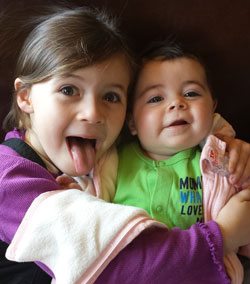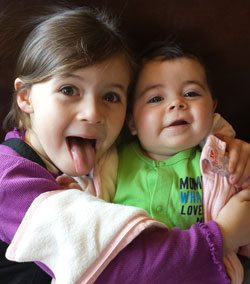 This piece, taken from Jennifer’s 2013 LifeWays paper, is the second of three installments:
This piece, taken from Jennifer’s 2013 LifeWays paper, is the second of three installments:
Becoming Worthy of Imitation
Looking into a child’s beautiful face, one realizes the responsibility that comes with the role of caregiver. It is a mighty thought to conceive: You, with all of your essence, have the power to alter and shape a life with your thoughts, gestures, voice, and sound. That is quite a bit to carry with you every moment of every day as we deal with life’s stresses and find ourselves deep in the future instead of living in the moment. What can we do with this power? How can we change if we find ourselves not who we want to be right now?
If we want the best for our children, we need to communicate with love and support at every turn as we aid in their development. This means we maintain this spirit even when they are discovering their own ability to act in the ways they choose and finding decisions they make may adversely affect themselves or others. We must remember that children will imitate the beings and environment by which they are surrounded. We cannot make an exception for our speech on one occasion and not expect our children in turn to make the same exceptions when they deem necessary.
Our goal is to strengthen our children so they become capable, kind individuals who will go into the world with love. As they grow, mental and emotional changes are occurring, as well as the development of their physical bodies. All of these aspects are built on language. When we grasp the idea that language can alter structures—that it can shape and change a material substance—we must think twice about the language we project into this world and to our children. The research and images produced by Hans Jenny in the 1960s are wonderful portrayals of the physical effects sound vibrations produce.
Hans Jenny coined the term “Cymatics” to describe the scientific field of the “structure and dynamics of waves and vibrations,” which also happens to be the title of a book he published on the subject. He used different materials, such as sand, water, and iron filings, to show what occurs when one places them on vibrating metal plates. He showed that if he increased the frequency of the vibration there was a significant increase in the intricacy of the patterns. If he increased the amplitude, the motions were more turbulent and rapid and could even result in small eruptions of the material.
At Left: The vowel ‘A’ in sand as produced by Hans Jenny.
When I reflect on Jenny’s work and the work of many others, I have to accept that the world around me is transformed by my voice. Even if you are unable to grasp the science, recall a time you were involved in a situation when someone spoke harshly to you. How did that experience make you feel? As you were subjected to this abrasiveness from another individual, did your heart race and your body tense? Perhaps it remained in your thoughts for sometime as you sorted out the experience in your mind? A miniscule moment in time affected you with such severity, and you are an adult who has had experiences and can process what occurred. Now imagine the same situation for a child.
Discipline is a difficult subject as we expect our children to be obedient; we may feel it reflects respect and showcases our role as an authority figure. I find that the times I have (gulp!) harshly spoken to my daughter, it turns out she has a perfectly good explanation for her actions. I have also discovered that if I live in the moment and work with my daughter instead of above her, our lives run smoothly together and we are both happy.
Jennifer Sullivan is a LifeWays Certified, Waldorf Teacher-in-Training, Mama of two beautiful girls ages 4 1/2 and 8 months.
